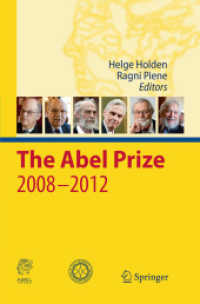Full Description
Spark a passion for STEM
Teaching STEM For Dummies is an easy-to-read and exciting new guide for teachers who want to inspire their students with engaging lessons and thoughtful discussions about science, technology, engineering, and mathematics. This practical roadmap to developing hands-on classroom material relevant to the real world shows you how to define STEM topics and overcome the most common challenges to teaching these complex subjects to younger students.
You'll learn how you can make STEM more welcoming—using inclusion, scaffolding, and differentiation—and discover resources for STEM teachers you can deploy immediately in your classroom.
Inside the book:
Understand the STEM concepts students are expected to learn at different grades and how to connect those ideas together in engaging lessons
Teach your students the inquisitive mindsets, logical reasoning, and collaboration skills they'll need to succeed in STEM fields
Increase STEM inclusivity in both the classroom and the industry by engaging all students in STEM from early ages
Discover resources to educate students on the problem-solving concepts at the core of STEM subjects
Perfect for teachers, homeschooling parents, tutors, and other educators, Teaching STEM For Dummies is a can't-miss read for anyone who wants to open young minds to the wonders of STEM.
Contents
Introduction 1
About This Book 1
Foolish Assumptions 2
Icons Used in This Book 3
Beyond the Book 4
Where to Go from Here 4
Part 1: Getting Started with Teaching Stem 5
Chapter 1: The Nuts and Bolts of STEM Education 7
Thinking about the Meaning of STEM. 8
Core STEM subjects 8
What different people mean when they say STEM 9
Helping Students Acquire Necessary Skills 10
Academic skills 11
Collaboration and employability skills 12
Embracing the Challenge (and Promise) of STEM Education 13
Establish a culture of learning 13
Motivate students with engaging lessons 15
Throwing Out the Old Rulebook 15
Chapter 2: What STEM Is (and Why It Matters) 17
Describing Core STEM Concepts 18
Science: How the world works 19
Technology: Tools of the trade 20
Engineering: Make it so 21
Mathematics: By the numbers 22
Adopting the Major Principles of STEM Education 23
Inquiry and project-based learning 23
Mistakes as cornerstones of learning 24
Integrating concepts across content 24
Centering the student 25
Equity and access in STEM 26
Iterations and reflection 27
Reaping the Benefits of STEM 28
Mirroring natural learning 28
Engaging hands and minds 28
Learning through play 31
Empowering through problem-solving and creativity 32
Developing collaboration and employability skills 33
Instilling digital and technological literacy 34
Chapter 3: Teaching STEM, Then and Now 35
Casting a Brief Look Back at U.S STEM Education 36
Teaching apprenticeships and early education 36
Looking at the rise of public education 37
Understanding the modern education policy 38
Digging into National Science and Engineering Standards 41
Describing desired outcomes 42
Process and practices: Discerning how you know 43
Connections and crosscutting concepts: Understanding how you think 44
Content and core ideas: Figuring out what you know 45
Bringing together the three dimensions 50
Exploring Math and Computer Science Standards 51
Looking at Common Core standards in mathematics 52
Looking at national standards for computer science 55
Part 2: Gathering the Building Blocks Of Stem 59
Chapter 4: Understanding the World with Science 61
Splitting Science into Buckets 62
Studying Matter and Energy 63
Getting to the heart of matter 63
Interacting with forces 67
Getting an energy boost 69
Catching the waves 71
Getting to Know Living Things 72
Processing the structure of life 73
Exploring the ecosystems 75
Passing along knowledge of heredity 76
Evolving an understanding of unity and diversity 77
Exploring the Planets (Including Earth) and Outer Space 80
Understanding space stuff 80
Catching up on the Earth 82
Examining humanity's impact 84
Some Brief Thoughts on the Scientific Method 86
Reviewing the scientific method steps 87
Recognizing the shortcomings 87
Needing more than memorized steps 88
Behind the method: Science and engineering practices 90
Mixing the Buckets Together 94
Crosscutting concepts 94
Integrating science into the real world 97
Chapter 5: Leveraging Computing and Technology Tools 101
Exploring Technology in the Classroom 102
Embracing the overlap 103
Focusing on computer-related technology 103
Living and Learning in a Digital World 105
This crazy little thing called the internet 105
Communicating and working through technology 106
Coding and Computer Science 110
Understanding computer hardware and software 110
Algorithms as the basis of coding 111
Coding with visual blocks and text 115
Incorporating Day-to-Day Technology 118
Preparing for the Future 119
Contextualizing modern technology 120
Dreading (and anticipating) the artificial intelligence revolution 121
Chapter 6: Encompassing Engineering Solutions 125
Centering Innovation and Invention 126
Embracing design principles 126
Adopting the tools of building and fabrication 128
Recognizing the main divisions: Mechanical and electrical engineering 130
Engaging the Engineering Design Process 132
Outlining design process steps 133
Examining design process activities 134
Focusing on Engineering Design Process Steps 135
Ask: What are we doing? 135
Imagine: What could we do? 137
Plan: Okay, let's do this! 138
Create: Actually do this! 139
Test: Did it work? 140
Improve and repeat: Keep doing it 142
Other Approaches to Engineering and Design Cycles 143
PLTW design process 144
Justin Gary's Core Design Loop 144
Physical Programming: Coding Meets Engineering 146
Introducing programmable physical objects 146
Robots and drones 147
Microcontrollers and microcomputers 147
Chapter 7: Crunching the Numbers with Mathematics 149
Thinking About Why We Learn Math 149
Knowing that Kids Will Use Math in the Future 150
Math in science and computer science 151
Psst, they know if you hate math 153
The hard truths about the hard stuff 153
Illuminating What We Talk About When We Talk About Math 156
Beyond computation and memorization 157
Organizing and representing data 158
Critical thinking, reasoning, and logic 160
Chapter 8: Mixing It Up: Integrating STEM Components 163
Combining STEM Areas 164
When using models and simulations 164
When testing hypotheses and solutions 166
Reading, Writing, and STEM 167
The importance of STEM background knowledge 167
Researching and writing with technology tools 170
Reading as the basis of STEM 172
Media Literacy as STEM 173
Promoting Justice for All: STEM and Society 174
STEAMing Up the Arts with STEM 175
Visual arts 175
Music, theater, and musical theater 176
Part 3: Employing Approaches to Stem Education 179
Chapter 9: Engaging Student Minds in a STEM Lesson 181
Unpacking the Learning Brain 182
Transitioning input into long-term memory 182
Following through with repeated exposure 183
Ensuring the connection of concepts 184
Inspiring a STEM Lesson 185
Starting points for STEM lessons 185
Refining STEM project ideas 186
Surface, deep, and transfer learning 188
Studying Up on STEM Teaching 189
POE model 190
5E model 191
OpenSciEd instructional model 195
Getting Students to Ask Questions 197
Guiding question boards 197
Soliciting group feedback 198
Including direct instruction 200
Probing background knowledge 200
Ensuring time for student feedback, iterations, and reflection 202
Embracing Collaboration and Student Roles 203
Chapter 10: Designing a STEM Curriculum 205
Focusing on the Standards Through a New Lens 206
Identifying key academic goals 206
Designing with the end in mind 208
Anticipating contingency plans 210
Setting the Scope, Sequence, and Pacing 211
Considering formal and informal requirements 211
Using gaps to your advantage 212
Revising and Iterating Your Curriculum 214
Chapter 11: Measuring and Assessing STEM 217
Knowing (and Assessing) What You're Trying to Teach 218
Assessing types of evidence and types of students 219
Considering levels of knowledge, learning, and understanding 220
Focusing on grade level skills 222
Offering Formative Assessment as Feedback 224
The Hard Skills: Assessing Content Knowledge 225
Keeping science notebooks 225
Focusing on the necessary academic goals 228
Allowing practical knowledge and skills to count for something 228
Letting students show their thinking 229
The Soft Skills: Assessing Collaboration and Employability Skills 230
Balancing teamwork and individual accomplishment 230
Looking toward future career choices 231
Trust the Experts: Students Evaluating Students 231
Chapter 12: Taking STEM to the Next Level 233
Letting Student Inquiry Lead the Way 233
Letting go of the classroom reins 234
Establishing trust going both ways 235
Fostering STEM student leadership 236
Learning Through Play 236
Exploring flow states and engagement 237
Highlighting the promise and peril of gamification 238
Encouraging the STEM Hobbyist 240
Forming clubs, organizations, and teams 240
Prioritizing STEM labs and makerspaces 242
Promoting maker fairs and entrepreneurship 243
Encouraging school and community projects 243
Part 4: Troubleshooting Stem Education 245
Chapter 13: Planning the STEM Classroom 247
Evaluating Your STEM Resources 247
Physical resources 248
Digital resources 249
Societal and community resources 250
Considering the Little Ones and the Big Ones 250
Simplifying concepts for younger students 251
Giving more autonomy to older students 252
Preparing STEM Educational Teams 253
Emphasizing the STEM approach 253
Communicating STEM expectations 254
Sending teachers to conferences 254
Chapter 14: STEM at Home (and Homeschool) 257
Personalizing Learning Goals 257
Targeting unique goals for a learner 258
Exploring depth as well as breadth 258
Expanding Beyond Just Study Time 259
Bonding over STEM Game Nights 261
Optimizing the gameschooling process 261
Examining the Terraforming Mars game 262
Chapter 15: STEM for All 265
Being a Voice for the Underrepresented 266
Surveying Traditional STEM Barriers 267
Incorporating Universal Design and Personalized Instruction 268
Instilling universal design in lessons 268
Adjusting lessons when needed 269
Part 5: the Part of Tens 271
Chapter 16: Ten STEM Lessons with Minimal Prep 273
Providing Free Build Time 273
Accessing an Hour of Code 274
Designing Storage Solutions 274
Making a Parachute 274
Setting Up a Tallest Tower Competition 275
Designing a Contraption 275
Making Oobleck 275
Building a Catapult 276
Conducting a Remote Control Race 276
Making an Egg Drop Challenge 276
Chapter 17: Ten Key Resources for Every STEM Teacher 277
Finding Online Interactive Simulations 277
Accessing Coding Platforms 278
Using Government Websites 278
Using Open Education Resources 279
Working with "Trash" STEM Building Supplies 279
Discovering University, Nonprofit, and Corporate Websites 280
Using the Calculator Application 280
Finding Digital Editing Suites and Resources 281
Locating Tinkercad and 3D Printing Websites 282
Looking for Citizen Science Communities and Resources 282
Index 283







